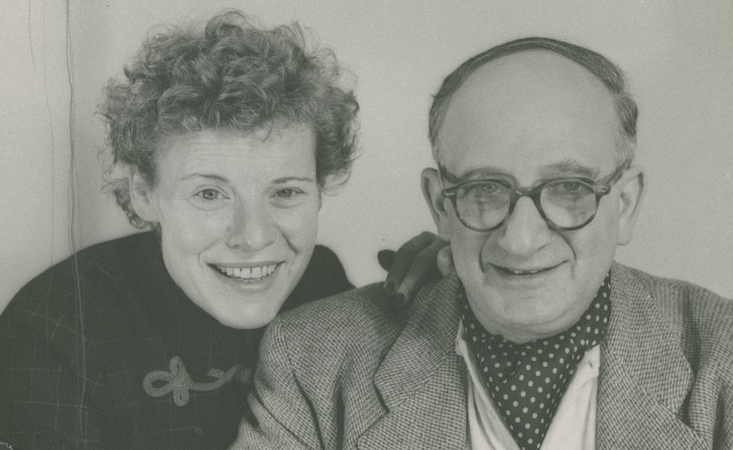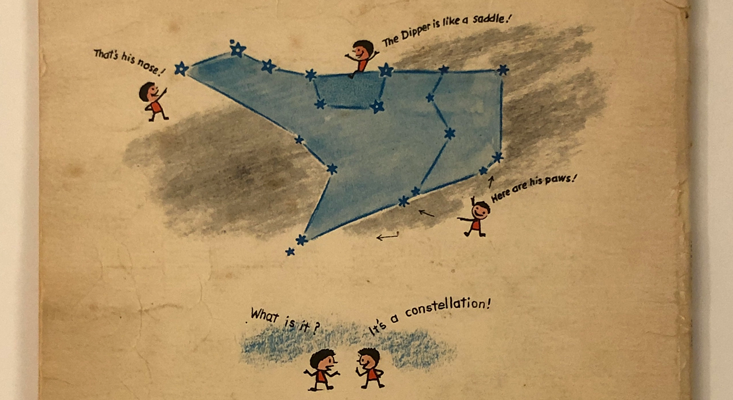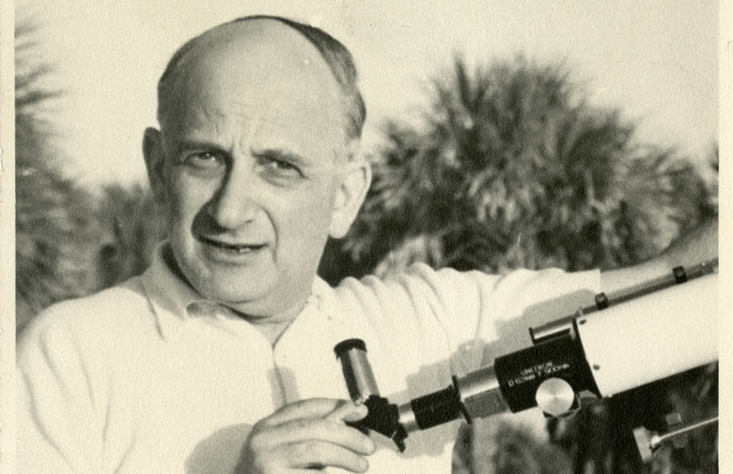He is without a doubt the most famous little monkey in all of fiction. Curious George, known for letting his inquisitiveness get him into trouble and then using his ingenuity to get him out of it, has been entertaining children and their parents since 1941, when the first book of his adventures, simply titled Curious George, by the husband-and-wife team of Margret and H.A. Rey, was published. It was followed by six more books; the last one, Curious George Goes to the Hospital, appeared in 1966. George has also starred in six animated feature films, and, since 2006, a PBS television series. Some 30 million copies of the George books have been sold, in 19 different languages.
The first Rey book that I encountered, however, had no monkeys whatsoever. As a kid growing up in Nova Scotia, with a keen interest in the stars and the universe, I devoured all the science books that I could find. I was lucky that my parents had books like Marvels and Mysteries of The World Around Us, a massive Reader’s Digest hardback that weighed as much as my head, which covered pretty much the whole universe. But it was aimed at adults and older kids, and anyway the astronomy stuff was squeezed into a few pages at the end. The little book that really got me hooked on the night sky was called Know the Stars, adapted from a longer work, Know the Constellations. The author was H.A. Rey.

Hans Augusto (“H.A.”) Rey and Margret Rey were German-Jewish refugees who fled Europe for America in 1940. Both were writers and illustrators; the George books largely bring together Margret’s words and Hans’s artwork. Hans’ first astronomy book, The Stars: A New Way to See Them, was published in 1952; Find the Constellations, aimed at younger readers, appeared in 1954. Although both books are monkey-less, there are clues they came from the same hand that brought George to life. Early in Know the Stars, for example, we find a little sketch of a 20th-century office worker transported to ancient Mesopotamia. It’s evening, and the constellation of Leo the lion is visible; a shepherd points it out to the baffled time-traveler. Find the Constellations features cartoon-like figures who similarly point out various features in the night sky.
Hans first took an interest in the stars while serving in the German army as a young infantryman during World War I—“long before George entered the picture,” Ellen Ruffin, curator of the de Grummond Children’s Literature Collection at the University of Southern Mississippi, in Hattiesburg, which houses the Rey archive, told me. At night, during breaks in the fighting, Rey looked skyward. What he saw looked nothing like the fanciful pictures in the popular astronomy books of the time. In one early 19th-century textbook, Leo the lion is drawn with a full mane of fur and a looping tail; with paws thrust forward, it seems ready to pounce. Only with great effort do we see the “backward question mark” (also called “the sickle”) at the lion’s front end—the only part of Leo that’s relatively easy to spot in the springtime sky—with the bright star Regulus marking the “dot” of the question mark. Similarly, Bootes the herdsman is depicted as a muscle-bound Greek figure; there is precious little resemblance to what one sees in the sky.
The first H.A. Rey book I encountered had no monkeys whatsoever.
Hans’ diagrams, in contrast, are almost breathtaking in their simplicity. He drew the constellations with clean lines, almost like stick figures. And, remarkably, they look like the people and animals that the ancients imagined, and they look like what you actually see when you look up at the sky (far from city lights, hopefully). Take Ursa Major (the Great Bear). Rey’s version looks like a bear, albeit a sort of stick-figure bear; at the same time, it clearly shows the seven stars within the bear that form the familiar “big dipper.” For Rey, Leo the lion has no mane and sports the world’s simplest tail; in fact, it could be a horse or just about any other quadruped. But it’s faithful to what we see when we look up. In Find the Constellations, a cartoon figure points to his front paw and says, “There’s a big star in his foot.” Yep, that’s Regulus.
My favorite Rey-ism is Gemini (the twins): It’s literally two stick-brothers holding hands, each one with a bright star where his head would be (and we soon learn their names: Pollux and Castor). Importantly, the star positions are accurate: Yes, he connected them with lines; but the stars are precisely where they’re supposed to be. Hans taught himself celestial cartography for this purpose, and to create the sky-view maps that appear in both The Stars and Find the Constellations. He uses larger dots to indicate brighter stars, and explains the “magnitude” system that professional astronomers use to denote the brightness of stars.
In The Stars (the book aimed at adults), Hans gives one of the best explanations of the “celestial sphere” that I’ve come across, including a concise explanation for why the constellations that we see vary over the course of the night and from season to season—the result, as Rey explains, of the Earth spinning on its axis while also revolving about the sun. The result of these two motions is that the stars rise about four minutes earlier from one night to the next. (Why four minutes? Because the solar day—which we set our clocks by—lasts 24 hours, while the sidereal day—the true length of the Earth to spin once on its axis, relative to the stars—takes just 23 hours and 56 minutes.) If not for these four minutes, Rey writes, “we should see the stars in exactly the same position at the same hour every night, and star-gazing would be the simplest thing in the world.” He continues: “Now four minutes a day does not sound like much but it adds up. In a month it makes 30 x 4 minutes = 2 full hours. One month from today the stars will rise two hours earlier than today.”
As Margret put it, Hans wrote about astronomy so clearly “that even adults can understand it.” Neither of Rey’s astronomy books has ever been out of print.
The Reys’ story is a remarkable one, and I’m embarrassed to admit that I only learned about it recently, through Louise Borden’s 2010 book, The Journey That Saved Curious George: The True Wartime Escape of Margret and H.A. Rey, and the media coverage that her book sparked.
Hans and Margret were both from Hamburg. In the 1930s, Hans was working in Brazil, selling bathtubs; Margret, who had studied art at the famous Bauhaus school and had worked in advertising, later moved to Brazil also. They married in 1935 and moved to Paris the following year, renting a flat in Montmartre. The city may have become their permanent home were it not for the rise of antisemitism under the Nazis. They fled in June 1940, just as German troops were closing in on the French capital, escaping on bicycles cobbled together from spare parts. They carried with them only their clothes and a satchel full of early George drawings. They made their way to Spain and eventually to Portugal; in Lisbon they caught a steamer to Brazil, and from there continued to New York. (Their story is also the subject of Ema Ryan Yamazaki’s charming 2017 documentary, Monkey Business, which also looks at the Reys’ lives more broadly.)
Like so many elements of our culture, the Curious George franchise has been the subject of intense scrutiny and re-evaluation in the 21st century. Some have balked at the premise of the first book, in which the Man with the Yellow Hat captures George in the African jungle and takes him across the ocean; for some, the echoes of the transatlantic slave trade are jarring. Writing in the New Yorker, Rivka Galchen observes that the first George story is “not a book that would be written in the same way today.” She adds: “The text seems oblivious to the resonances with the Middle Passage, and those resonances now feel at once buried and overwhelming.”

What we read into the books today does not, of course, tell us very much about what its creators were thinking 80 years ago. We know the Reys were no fans of fascism, having barely escaped Hitler’s genocidal regime with their lives. We might also take note of Margret’s 1945 book, Spotty; illustrated by Hans, it relates the adventures of a spotted rabbit struggling for acceptance in a world full of all-white rabbits. It is an explicitly pro-tolerance, pro-diversity tale. Meanwhile, the George franchise has evolved with the times: In a 2006 movie, George is not captured but rather sneaks onto the America-bound ship as a stowaway.
Though much less well known than the George books, Hans’ astronomy books have also left their mark. The New York Times, reviewing The Stars in 1952, said it “represents the pictorial method of teaching at its best. It is almost certain to become standard equipment among amateur star gazers.” And so it did. In fact, some of those amateurs went on to become professional astronomers. Jim Hesser, who served as director of the Dominion Astrophysical Observatory in British Columbia for almost three decades, was excited about the night sky as a youngster—but, like Rey, he was put off by the unrealistic artwork in astronomy guides of the time. “Discovering [Rey’s] book was a turning point, for which I’ve long been grateful,” Hesser told me. “I have recommended it time and time again to newcomers.”
Rey gives one of the best explanations of the celestial sphere.
After first settling in New York, the Reys relocated to Cambridge, Mass., in 1963. Beginning in the 1950s, however, they spent their summers in Waterville Valley, New Hampshire. Although the Reys are long gone—Hans died in 1977, Margret in 1996—they’re fondly remembered by residents of Waterville Valley. People recall the informal stargazing sessions that Hans hosted on clear summer nights, setting up his telescope at the local golf course, and welcoming anyone who came by to see what he was up to.
Nat Scrimshaw, 61, was a child when he first met the Reys; he still lives just a few miles away. Central New Hampshire is known for its natural beauty, though the encroaching condos have made Waterville Valley less tranquil than it once was. Back in the ’60s, Scrimshaw recalled, there was just the Waterville Inn and a few cottages. With hardly any light pollution, “you could just go out at night and have this incredible view of the stars.”
Before Scrimshaw and I ended our conversation on Zoom, he picked up his tablet and walked a short distance down the road to the home of Penny Palmer, another long-time resident who has warm memories of the Reys, and of Hans’s stargazing sessions. “Our parents would be at the bar at the inn, drinking, and we’d go out to the fairway until we saw this tiny little flashlight, and that was Mr. Rey,” Palmer said. “So that’s how we found him.”

Rey would set up his small refractor telescope to look at the moon, planets, and stars; he’d point out the constellations to whoever happened to drop by. Pocket lasers had not yet been invented, but Palmer remembers how Rey improvised the next best thing: He used Margret’s nail polish to paint the front of his flashlight so that it emitted just a narrow beam in the shape of an X, which was perfect for pointing things out in the night sky. She also remembers the one time that the usually calm Rey lost his cool. Palmer’s young cousin “thought it would be funny to shine a flashlight down the telescope tube. And Mr. Rey, who was the sweetest man in the world, just went ballistic.”
As Scrimshaw grew up, his relationship with Rey evolved. As a child, he loved visiting Rey in his studio and watching him draw, “seeing this kind of magic, that he could create these characters with colored pencils and chalk.” As Scrimshaw became a young man, their conversations deepened. “He loved to talk history, science, art. He was a true renaissance man, very educated in many different disciplines; he spoke multiple languages. When I was in high school, I would visit and talk with both Margret and Hans; that’s when he went from ‘Mr. Rey’ to ‘Hans.’”
In later life, Hans became an environmentalist, likely sparked by the energy crisis of the 1970s; he was especially keen on wind energy. Having experienced the horrors of war firsthand, he was also a vocal pacifist, and strongly opposed the war in Vietnam. One of the most remarkable artifacts in the de Grummond collection is a copy of a letter that Rey wrote to President Nixon in 1972, decrying “mechanized mass murder from 50,000 feet up in the air.” Even if the U.S. were to win the war, he wrote “that victory would bring no glory to the United States, but lasting shame.”
While Scrimshaw doesn’t consider himself an artist, he always enjoyed doodling; these days, inspired by Rey’s legacy, he gives “chalk talks” at the Margaret and H.A. Rey Cultural Center in Waterville Valley, and at children’s hospitals. When he draws, he channels his old friend. “Hans would grab a sheet of paper and quickly draw different characters, and make up stories about them—and then give the drawings away to the kids,” Scrimshaw said. The staff at the Rey Center, meanwhile, continue to host summertime stargazing sessions, and the local municipal government recently adopted a dark sky ordinance to fight light pollution by regulating outdoor lighting—a small step toward preserving the sky that Hans Rey loved so much.
Dan Falk (@danfalk) is a science journalist based in Toronto. His books include The Science of Shakespeare and In Search of Time.
Lead image: Photo of a page of H.A. Rey’s Know the Stars.






























